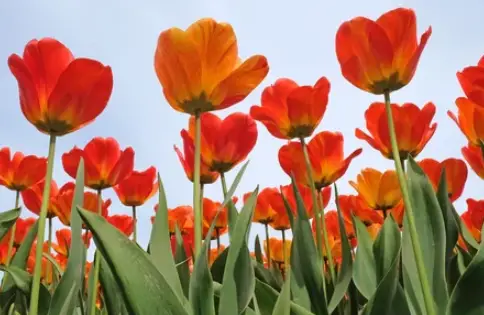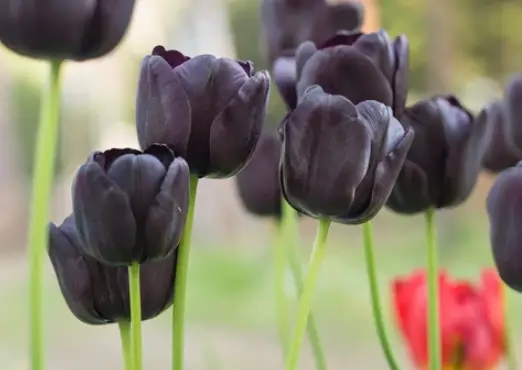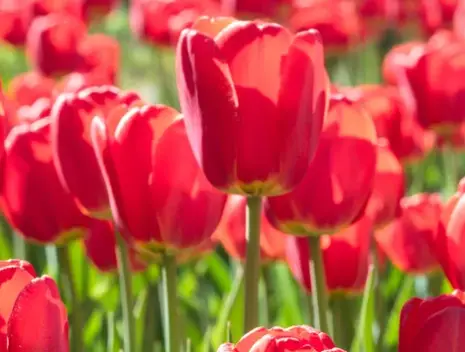Tulips are one of the most beautiful and popular flowers in the world.
Their vibrant colors and delicate petals make them a favorite for gardeners and flower enthusiasts alike.
However, growing tulips in Texas can be a bit challenging due to the state’s hot and dry climate.
But fear not, with the right techniques and care, you can successfully grow tulips in your Texas garden. Here’s how.
How to Choose the Right Tulip Varieties
Before you start planting tulips in Texas, you need to choose the right tulip varieties. Since Texas has a warm climate, you should select tulip bulbs that are suitable for warmer temperatures. Some of the best tulip varieties for Texas include: Darwin Hybrid Tulips, Triumph Tulips, and Single Early Tulips
Darwin Hybrid Tulips

how to grow tulips in texas
Darwin Hybrid tulips are a popular group of tulip cultivars that are known for their large, showy blooms and sturdy stems. They are a cross between two different tulip species, Tulipa fosteriana and Tulipa gesneriana, and were developed by Dutch breeders in the mid-20th century.
These tulips are known for their vibrant colors, which range from bright reds, pinks, and oranges to softer pastels and whites.
They typically bloom in mid-spring and can grow up to 2-3 feet tall, making them an impressive addition to any garden or landscape.
One of the main advantages of Darwin Hybrid tulips is their sturdiness.
Unlike some other tulip cultivars, Darwin Hybrids have strong, sturdy stems that are less likely to flop over or break in the wind or rain. This makes them a popular choice for cut flower arrangements as well as garden beds.
When planting Darwin Hybrid tulips, it’s important to choose a location with well-draining soil and full sun or partial shade. These tulips prefer slightly acidic soil with a pH of around 6-7.
To encourage healthy growth and blooming, add a slow-release fertilizer to the soil when planting.
Triumph Tulips

Triumph Tulips
Triumph tulips are a popular group of tulip cultivars that are known for their classic tulip shape and bold, bright colors.
They are a hybrid of two other tulip species, Tulipa fosteriana and Tulipa gesneriana, and were developed in the Netherlands in the mid-20th century.
One of the main features of Triumph tulips is their sturdy stems, which make them well-suited for cut flower arrangements as well as garden beds.
They typically grow to be around 12-18 inches tall and bloom in mid-spring.
Triumph tulips come in a wide range of colors, from deep reds and purples to bright pinks, oranges, and yellows.
They also come in some pastel shades like pink and peach. Some popular cultivars include ‘Apeldoorn’, which is a bright red tulip, ‘Golden Apeldoorn’, which is a yellow tulip, and ‘Negrita’, which is a deep purple tulip.
When planting Triumph tulips, it’s important to choose a location with well-draining soil and full sun or partial shade.
They prefer slightly acidic soil with a pH of around 6-7. To encourage healthy growth and blooming, add a slow-release fertilizer to the soil when planting.
Single Early Tulips

Single Early tulips are a popular group of tulip cultivars that are known for their elegant, cup-shaped flowers and early bloom time.
They are one of the oldest types of tulips, with some cultivars dating back to the 16th century.
One of the main features of Single Early tulips is their compact size, with most cultivars growing to be around 10-12 inches tall.
They typically bloom in early to mid-spring and come in a wide range of colors, including bright reds, pinks, and yellows, as well as softer pastels and whites.
Some popular cultivars of Single Early tulips include ‘Apricot Beauty‘, which is a soft pink-orange tulip, ‘Prinses Irene’, which is an orange and purple bi-colored tulip, and ‘Keizerskroon‘, which is a red and yellow bi-colored tulip.
When planting Single Early tulips, it’s important to choose a location with well-draining soil and full sun or partial shade. They prefer slightly acidic soil with a pH of around 6-7.
To encourage healthy growth and blooming, add a slow-release fertilizer to the soil when planting.
Choosing the Right Location

When planting tulips, it’s important to choose a location that receives plenty of sunlight. Tulips need at least six hours of direct sunlight per day to grow and bloom properly. Avoid planting tulips in areas with heavy shade or areas that are prone to standing water.
Preparing the Soil
Once you’ve selected your tulip bulbs, you need to prepare the soil. Tulips prefer well-drained soil with a pH level of 6.0 to 7.0.
You can add compost, peat moss, or sand to improve drainage and soil quality. You can also add some bone meal or bulb fertilizer to promote healthy growth and blooming.
When to Plant Tulip Bulbs
Tulip bulbs should be planted in the fall, around mid-November to early December, before the ground freezes. To plant tulips, dig a hole that is two to three times the size of the bulb, and about six inches deep.
Place the bulb in the hole, with the pointed end facing upward. Cover the bulb with soil, and water thoroughly. You can plant tulips in rows or clusters, depending on your preference.
Caring for Tulips
Once you’ve planted your tulip bulbs, it’s essential to care for them properly to ensure healthy growth and blooming. Here are some tips to care for your tulips:
- Water your tulips regularly, about one inch of water per week. Tulips prefer moist soil but avoid overwatering, as it can lead to root rot.
- Fertilize your tulips once a month during the growing season with a bulb fertilizer.
- Deadhead your tulips after they bloom. This means removing the dead flowers to promote new growth and blooming.
- Mulch around your tulips to retain moisture and control weeds.
- Protect your tulips from extreme heat or cold by covering them with a light cloth or shade cloth.
Dealing with Warm Winters
Texas winters can be mild, which means that the ground may not freeze solidly.
This can cause problems for tulips, as they require a cold period to develop properly.
To overcome this, you can chill your tulip bulbs in the refrigerator for at least six weeks before planting them. This will simulate a cold winter and encourage your tulips to bloom properly.
Protecting Tulips from Pests and Diseases
Tulips can be vulnerable to pests and diseases, especially in hot and humid climates like Texas.
Some common pests that may attack your tulips include aphids, thrips, and spider mites. To prevent pest infestations, you can use insecticidal soap or neem oil.
Diseases such as bulb rot, gray mold, and tulip fire can also affect your tulips. To prevent diseases, make sure to plant your tulips in well-drained soil, avoid overwatering, and remove any infected plants immediately.
Storing Tulip Bulbs
Once your tulips have finished blooming, you can dig up the bulbs and store them for the next growing season. To do this, wait until the foliage has completely died back, then dig up the bulbs and gently remove any soil. Allow the bulbs to dry in a cool, dry place for a few days before storing them in a cool, dry location until fall.
Harvesting Tulips
Once your tulips have bloomed, you can harvest them by cutting the stem about two inches above the bulb. Tulips make great cut flowers and can be used in floral arrangements or as a gift.
Conclusion
Tulips are difficult to cultivate in Texas, but with the appropriate methods and attention, you may have the beauty of these blooms in your garden.
Tulips may be kept healthy and attractive year after year if you choose the ideal location, deal with warm winters, protect them from pests and diseases, and store your bulbs properly.
So why not use these gorgeous flowers to inject some color into your Texan garden?




